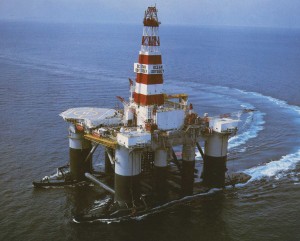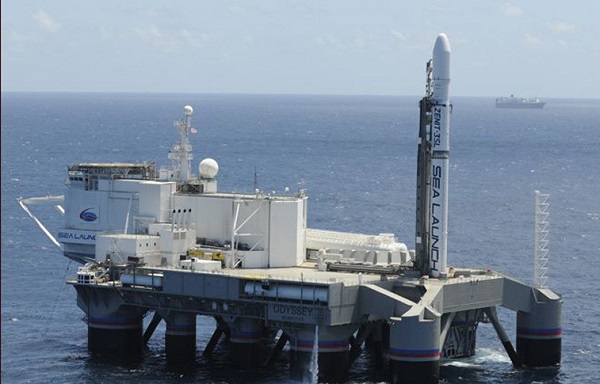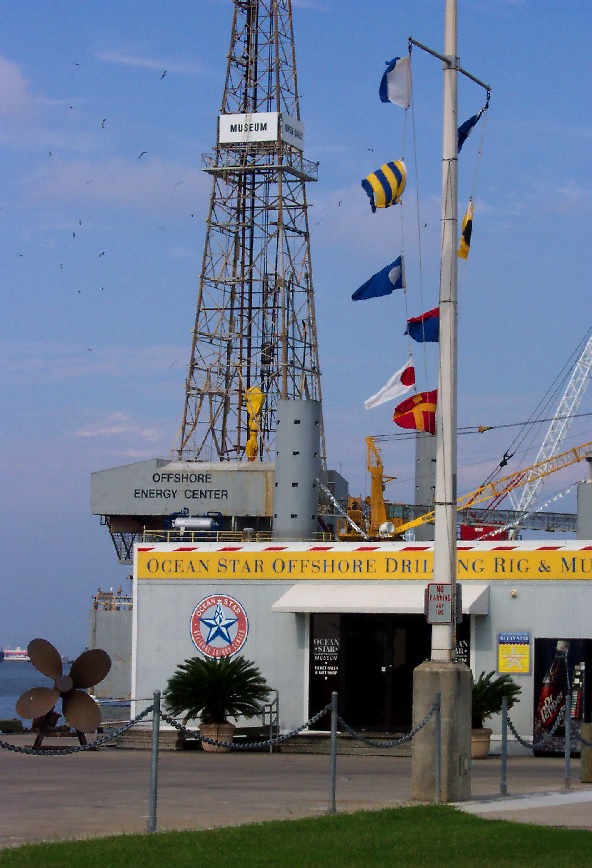Ocean Odyssey — first mobile offshore platform converted to launch rockets from the equator.
Offshore oil and natural gas platforms have proven useful after retirement. Hundreds of former platforms serve as aquatic habitats. A jack-up rig in Galveston, Texas, is an offshore museum. There’s a historic mobile rig in Morgan City, Louisiana, that in 2024 was added to the National Register of Historic Places. Another mobile platform launched satellites from 1999 to 2014.
About 10 percent of the thousands of decommissioned petroleum production platforms in the Gulf of Mexico have been converted to permanent reefs, according to the National Oceanic and Atmospheric Administration (learn more in Rigs to Reefs).

In October 1999, a Boeing-led consortium of international companies used Russian-made rockets to launch satellites from the Ocean Odyssey, a converted semi-submersible drilling platform — and the world’s first floating equatorial launch pad. Photo courtesy Sea Launch.
In Galveston Bay, Texas, a retired jack-up drilling rig, the Ocean Star, opened as a petroleum museum in 1997 after drilling more than 200 wells. Another offshore museum, Mr. Charlie in Morgan City, Louisiana, was the first submersible drilling rig when it was launched in 1953 (see Mr. Charlie, First Mobile Offshore Drilling Rig).
The Ocean Odyssey, a self-propelled, semi-submersible drilling platform designed to endure 110-foot North Atlantic waves, became a floating equatorial launchpad.
Floating Rocket Launcher
On March 27, 1999, a Russian Zenit-3SL rocket — fueled by kerosene and liquid oxygen — placed a demonstration satellite into geostationary orbit from the Ocean Odyssey’s remote Pacific Ocean launch site (Latitude 0° North, Longitude 154° West).
“The Sea Launch rocket successfully completed its maiden flight today,” Boeing announced. “The event, which placed a demonstration payload into geostationary transfer orbit, marked the first commercial launch from a floating platform at sea,” the company added in a news release.

Constructed in Japan in 1982, the Ocean Odyssey was designed to endure 110-foot waves before it became a movable, floating equatorial launchpad. Photo courtesy Sea Launch.
Sea Launch, a Boeing-led consortium of companies from the United States, Russia, Ukraine, and Norway, began commercial launches on October 9, 1999, using a Russian Zenit-3SL rocket with a DirecTV satellite payload. By 2014 the Ocean Odyssey had made 36 such launches for XM Satellite Radio, EchoStar and communication companies.
Originally to have been named Ocean Ranger II, the $110 million platform was under construction in Yokosuka, Japan, on February 15, 1982, when its namesake and predecessor tragically capsized in a North Atlantic storm off Newfoundland, killing all 84 men aboard. Renamed Ocean Odyssey, the new offshore drilling platform went to work that same year.
Between April 1983 and September 1985, the platform drilled off the coasts of Alaska and California before a two-year hiatus. In early 1988, the Ocean Odyssey was contracted to Atlantic Richfield Company (ARCO) for North Sea explorations.
All went well until September 1988, when a blowout and fire ended the offshore platform’s oilfield career.

Prior to economic troubles, Sea Launch launched Russian Zenit-3SL rockets to carry Hughes Space and Communications satellites into geosynchronous orbits. Photo courtesy Sea Launch.
After spending several years as a rusting hulk in the docks of Dundee, Scotland, advancing aerospace technologies came to the rescue of the self-propelled platform, 436 feet long and about 220 feet wide.
The advantages of space launches from the equator — and the availability of the Ocean Odyssey — prompted Boeing to convert the rig into a launch platform. According to experts, the speed of earth’s rotation is greatest at the equator, providing a minor extra launch boost.
By April 1995, Boeing (with 40 percent ownership) led a four-country joint partnership, Sea Launch LLC. The venture included Russia (25 percent), Norway (20 percent), and Ukraine (15 percent).

Ocean Odyssey’s last launch came in May 2014, a few months after armed conflict began in eastern Ukraine. Bankruptcy and years of litigation followed. Photo courtesy Steve Jurvetson.
Thanks to Ocean Odyssey, a new offshore space industry was launched. The consortium established its U.S. home port in Long Beach, California, near satellite, aerospace, and maritime supply companies. Before the end of 1995, Hughes Space and Communications had contracted for 10 launches.
However, economic and legal troubles emerged. After almost 40 launches (with three failures), operating costs and a declining world economy led to Sea Launch’s Chapter 11 bankruptcy and reorganization in 2009. Russia emerged with 95 percent ownership.

The offshore drilling rig Ocean Star in 1997 opened as a museum in Galveston, Texas. 2005 photo by Bruce Wells.
Then began litigation, claims, and counter-claims within the Sea Launch consortium. Ocean Odyssey’s last launch came on May 26, 2014, months after Russia annexed Ukraine’s Crimean Peninsula.
Financial reports estimated the company’s debt at $1 billion when the consortium filed for bankruptcy, with assets of up to $500 million. The cost per launch was more than $80 million as Boeing sued to recoup $356 million of a reported $978 million loss in loans, trade debt, and partner liabilities.
By the end of 2014, the Ocean Odyssey and its command ship, Sea Launch Commander, were moored at Long Beach, California.
In 2020, the Sea Launch platform’s future remained uncertain. “The two vessels that serve as a floating launch platform and command ship for Sea Launch are now in a Russian port, but the company’s owner says no launches are planned for the foreseeable future,” noted SpaceNews.
Ensco Semi-Submersibles
Relocated to Russia, the future of the aging Ocean Odyssey rocket platform remained uncertain at the end of 2020. Meanwhile, Elon Musk of SpaceX in January 2021 announced plans to build “floating, super heavy-class spaceports for Mars, moon & hypersonic travel around Earth,” according to a CNBC article.
SpaceX subsidiary Lone Star Mineral Development purchased two deep-water rigs for $7 million from the offshore drilling contractor Valaris, which had filed for bankruptcy.
Semi-submersible rigs like the Ensco series “differ from drilling ships in that they sit on pontoons that are pushed under the water, below the waves, which gives them greater stability,” according to the 2021 article, “More About SpaceX’s Oil Rigs,” at CleanTechnica.
The semi-submersible platforms, part of a series built by Ensco between 2005 and 2012, were renamed Deimos and Phobos (the moons of Mars) and relocated to the Port of Brownsville, Texas, near the SpaceX Starship facility in Boca Chica.
Although SpaceX later sent the two semi-submersibles to Pascagoula, Mississippi, for conversion, the work was abandoned after it was decided “they were not the right platform” for sea-based launches. SpaceX sold both rigs in 2023.
For more petroleum exploration and production articles, see Offshore Petroleum History. For exhibits, Houston-based Offshore Energy Foundation offers energy education programs in addition to maintaining the Ocean Star Museum.
More petroleum history can be found by a visit to the world’s first mobile offshore platform, Mr. Charlie, in Morgan City, Louisiana, today a museum and education center. In 2024, Mr. Charlie was designated a National Historic Landmark — the fifty-fourth in Louisiana, the first in St. Mary Parish, and “the first in the country representing the offshore oil and gas industry,” according to Virgil Allen, longtime manager of the historic rig.
The American Oil & Gas Historical Society supported his lengthy effort, beginning with a 2021 letter to the Landmarks Preservation Program Committee.
_______________________
Recommended Reading: Offshore Pioneers: Brown & Root and the History of Offshore Oil and Gas (1997); Oil and Gas Pipeline Fundamentals
(1993); Natural Gas: Fuel for the 21st Century
(2015). Your Amazon purchase benefits the American Oil & Gas Historical Society. As an Amazon Associate, AOGHS earns a commission from qualifying purchases.
_______________________
The American Oil & Gas Historical Society (AOGHS) preserves U.S. petroleum history. Please become an AOGHS annual supporter and help maintain this energy education website and expand historical research. For more information, contact bawells@aoghs.org. Copyright © 2025 Bruce A. Wells. All rights reserved.
Citation Information: Article Title: “Offshore Rocket Launcher.” Authors: B.A. Wells and K.L. Wells. Website Name: American Oil & Gas Historical Society. URL: https://aoghs.org/technology/offshore-rocket-launcher. Last Updated: October 4, 2025. Original Published Date: January 2, 2015.




